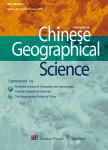Regenerative Role of Soil Seed Banks of Different Successional Stages in A Saline-alkaline Grassland in Northeast China
Regenerative Role of Soil Seed Banks of Different Successional Stages in A Saline-alkaline Grassland in Northeast China作者机构:Da'an Sodic Land Experiment StationNortheast Institute of Geography and AgroecologyChinese Academy of SciencesChangchun 130102China Erguna Forest-Steppe Ecotone Research StationKey Laboratory of Forest Ecology and ManagementInstitute of Applied EcologyChinese Academy of SciencesShenyang 110016China State Key Laboratory of Atmospheric Boundary Layer Physics and Atmospherie ChemistryInstitute of Atmospheric PhysicsChinese Academy of SciencesBeijing 100029China
出 版 物:《Chinese Geographical Science》 (中国地理科学(英文版))
年 卷 期:2018年第28卷第4期
页 面:694-706页
核心收录:
学科分类:0303[法学-社会学] 090503[农学-草业科学] 0909[农学-草学] 0905[农学-畜牧学] 0708[理学-地球物理学] 09[农学] 0705[理学-地理学] 0903[农学-农业资源与环境] 0813[工学-建筑学] 0704[理学-天文学] 0833[工学-城乡规划学]
基 金:Under the auspices of National Basic Research Program of China(No.2015CB150802) National Natural Science Foundation of China(No.41371260,41771058) National Key Research&Development Program of China(No.2016YFC0501200) National Key Basic Survey of Resources(No.2015FY110500)
主 题:soil seed bank seed dispersal ecological restoration phenology succession seed rain
摘 要:Soil seed banks can act as a potential seed source for natural revegetation and restoration. However, in a saline-alkaline grassland, it remains unclear how the stages of vegetation succession affect the characteristics of soil seed banks and the potential of soil seed banks of different successional stages for vegetation restoration. In this study, seasonal changes of the soil seed bank, and seed production and dispersal dynamics along degradation successional gradients were investigated in a saline-alkaline grassland in Northeast China, where the dominant grass during the 1960 s, Leymus chinensis was replaced with the secondary successional order of Puccinellia chinampoensis, Chloris virgata, and Suaeda salsa, together with bare patches. It was found that the soil seed bank composition varied according to the changing vegetation and had the highest species richness(7–16) in the climax successional stage, but had a low S?rensen similarity(0.22–0.37) with the aboveground vegetation. There was a high seed density of the soil seed bank(21 062–62 166/m2 in August and December) and also high S?rensen similarity index values(0.47–0.60) in the secondary successional stages of P. chinampoensis, C. virgata, and S. salsa. In bare patches, there were many seeds in the soil seed bank and some seedlings also appeared in the aboveground vegetation, indicating the existence of a persistent soil seed bank. Seed density and species richness differed substantially among the different successional stages, which was related to the reproductive characteristics of the standing plants in vegetation communities. Due to the lack of propagules of perennial species, especially the climax species of L. chinensis, in the soil, the successful restoration of the degraded saline-alkaline grassland was not possible. The study proved that in a degraded saline-alkaline grassland dominated by biennial or annual species, the soil seed bank was important for the revegetation of the current dominant pla



